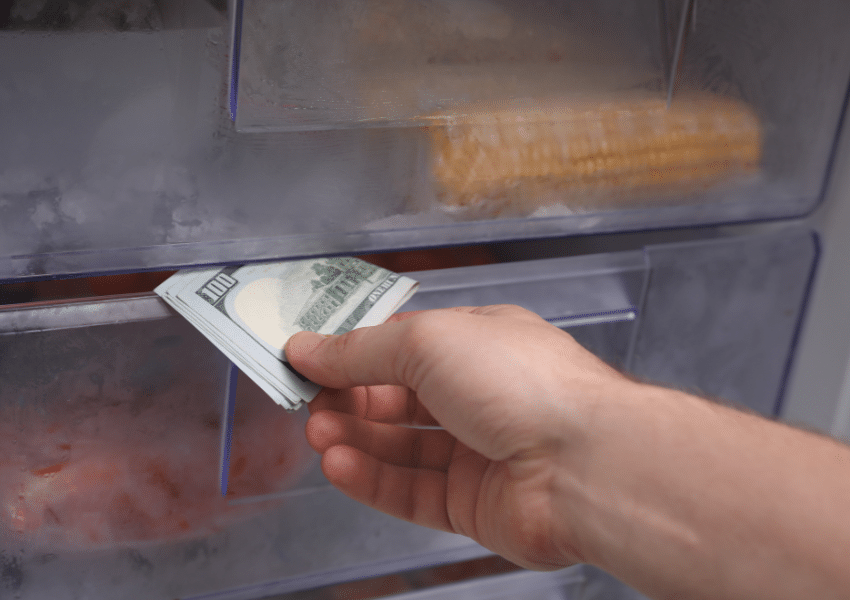
by California Casualty | Helpful Tips, Homeowners Insurance Info |
Think you’ve found the perfect hiding spot for your cash or jewelry? Think again. From the freezer to the sock drawer, burglars know all the “secret” places homeowners use to stash their valuables. Before you tuck away your treasures in plain sight, learn which hiding places offer false security — and where your valuables will truly be safe.
Front Door
We’ve all heard the advice about keeping a spare key “just in case,” but hiding one near your front door is practically an open invitation. The doormat, flowerpot, mailbox, or fake rock –these are the first places a burglar will check. If you need to keep an extra key, leave it with a trusted neighbor instead.
Entryway
Your entry table may be the perfect place for dropping your car keys, wallet, or spare cash when you walk in, but it’s also the first stop for an intruder. Those items are quick to grab and easy to carry. A thief could be in and out of your home in under a minute with your keys, ID, and bank cards in hand.
Bedrooms
Burglars make a beeline for the master bedroom because they know that’s where people store their most valuable items — cash, jewelry, and small electronics. They’ll check dresser drawers, armoires, sock drawers, and even the space under your mattress. Suitcases and storage boxes? Those are fair game, too. The very spots that are most convenient for you are the ones they will check.
Freezer
Think your freezer is foolproof? Think again. Many homeowners wrap cash or jewelry in plastic and tuck it behind the frozen vegetables. But this “clever” hiding place is common knowledge among burglars. If it’s easy for you to access, it’s easy for them to find.
Bathrooms
Your bathroom medicine cabinet may seem like a private place, but it’s often one of the first areas a thief will check — especially if they’re looking for prescription drugs to sell. Don’t keep cash or jewelry there either; it’s too easy to reach.
Cookie Jar
It might seem like a sweet spot to stash your grocery money, but thieves know this classic trick. The same goes for flour tins and coffee canisters. If it’s in plain sight in the kitchen, assume it’s on a burglar’s radar.
Home Office
Your office is a goldmine for identity thieves. Computers, passports, checkbooks, and tax forms can all be used to steal your identity or drain your accounts. Keep sensitive documents locked away and back up important files to a secure cloud account.
Portable Safes
A small safe can keep kids or guests out of your valuables, but it won’t stop a thief from carrying the whole thing out the door. Unless your safe is bolted to the floor or wall, it’s just another box waiting to be picked up and opened later.
Other Bad Spots
Anywhere damp, dirty, or difficult to monitor is also a poor choice. Inside toilet tanks, for example, may seem clever, but the moisture can ruin documents and cash.
Where to Hide Your Valuables Instead
The best hiding places are the ones that require effort to access or don’t make sense for a thief to bother with. Think inconvenient, hidden, or disguised. Here are some ideas.
Trash Can with a False Bottom
A cleverly designed trash can with a hidden compartment can be a surprisingly effective deterrent. Thieves are unlikely to rummage through garbage. Just make sure your valuables are sealed against moisture — and don’t accidentally toss them out on trash day!
Fake Wall Outlets
You can purchase wall outlets that look completely real but pull out to reveal a small hidden compartment. They’re perfect for storing cash, jewelry, or small documents. Just be sure the outlet isn’t connected to any wiring.
Hidden Household Items
Fake food cans or containers designed to mimic ordinary products — like shaving cream or soup — are a discreet way to hide valuables. You can even make your own by hollowing out real cans. Just be careful to make them look authentic, and don’t place them in high-traffic areas where someone might mistake them for the real thing.
Structural Hiding Spots
If you’re handy, consider creating built-in hiding spaces behind removable panels or trim. Hollowed-out wainscoting, door jambs, or floorboards can be excellent concealment spots. Pre-made versions are also available for purchase and can be installed without major renovations.
Books and VHS Cases
A hollowed-out book on a crowded bookshelf — or an old VHS tape in a dusty box — won’t draw a second glance. Just don’t use a book or a tape case you might mistakenly donate.
Storage Bins
Large, unlabeled bins can attract attention, so disguise your valuables among ordinary items. Label bins with dull titles like “Old School Projects,” “Holiday Décor,” or “Winter Clothes.” Even if burglars do open a few, they’re unlikely to dig deep through boxes of tinsel or kids’ art supplies.
Kids’ Bedrooms
While the master bedroom is a prime target, thieves usually skip children’s bedrooms. Consider stashing your valuables in a box on a high shelf in the closet. Further protect it with a misleading label.
Add an Extra Layer of Security
Even the best hiding spots can’t protect your valuables completely. Strengthen your security by:
- Installing a home security system with cameras and alarms to deter burglars.
- Using motion-sensor lighting around entry points to discourage nighttime intrusions.
- Keeping your valuables insured through your homeowner’s or renter’s policy so you’re financially protected even if the worst happens.
By avoiding the most obvious hiding places and thinking creatively about security, you can protect your valuables and your peace of mind.
This article is furnished by California Casualty, providing auto and home insurance to educators, law enforcement officers, firefighters, and nurses. Get a quote at 1.866.704.8614 or www.calcas.com.

by California Casualty | Auto Insurance Info, Helpful Tips, Travel |
The fall and winter holidays are here, and that means one thing — road trip season! Whether you’re packing up the car for a cozy weekend with family or planning a winter getaway, a little prep now can make the miles ahead smooth and stress-free. So before you hit the highway, let’s make sure both your car and your crew are road trip ready.
1. Give Your Car a Quick Checkup
Take some time to make sure your vehicle is in good shape. A simple once-over now can prevent big headaches later.
- Tires: Start from the ground up. Check tread depth using the penny test — if you can see the top of Lincoln’s head, it’s time for new tires. Adjust the air pressure to the manufacturer’s recommendation (listed on the inside of your driver’s door), and make sure your spare tire is in good shape and properly inflated.
- Battery: Car batteries tend to struggle in extreme temperatures. If your battery is more than three years old, have it tested before your trip. A weak battery can leave you stranded in a rest area or gas station parking lot — never fun with a trunk full of luggage and kids in the back seat.
- Lights: Do a quick walk-around to check your headlights, taillights, brake lights, and turn signals. Replacing a bulb takes only a few minutes and improves both visibility and safety.
- Oil & Fluids: If you’re due (or close to due) for an oil change, take care of it before your trip. Clean oil helps your engine run more efficiently on long drives. Don’t forget to top off brake fluid, power steering fluid, windshield washer fluid, and coolant (anti-freeze) — especially if you’re heading into colder weather.
- Belts & Hoses: Pop the hood and look for cracks, fraying, or leaks. Worn-out belts and hoses are a common cause of breakdowns on long drives.
- Recalls: Before you leave, take a minute to look up your VIN at gov/recalls. It’s an easy way to see if your car has any unaddressed safety issues.
2. Stock Up and Plan for Emergencies
Even with the best prep, life can throw a curveball. A well-stocked emergency kit ensures you’re ready for whatever comes your way. Pack these essentials:
- Jumper cables
- First aid kit
- Flashlight with extra batteries
- Blankets or emergency thermal wraps
- Reflective triangles or road flares
- Tire pressure gauge
- Tire sealant for small punctures
- Multipurpose tool or pocketknife
You’ll also want to keep a portable phone charger or power bank handy, especially if your car doesn’t have USB ports. Toss in personal medications, a small stash of cash (for tolls or emergencies), and some bottled water and nonperishable snacks in case you get delayed. For comfort, include pillows, cozy blankets, and a travel cooler filled with snacks and drinks. A happy car equals happy passengers — and fewer unscheduled pit stops!
3. Keep It Clean and Comfortable
Nothing ruins a road trip faster than clutter and chaos. Before you go, clean out the interior and start with a fresh, organized space. Make sure to bring along:
- A small trash bag or reusable bin for wrappers and napkins
- Hand sanitizer and disinfecting wipes for quick cleanups
- A travel-size tissue pack or paper towels
If you’re traveling with kids, you may want to childproof your car and stock up on car-friendly activities — audio books, travel games, or coloring pads. For adults, download your favorite playlists or podcasts before leaving areas with spotty reception. Little touches like seat cushions, neck pillows, or a cozy throw blanket can turn long stretches of highway into something a bit more comfortable.
4. Don’t Forget the Paperwork
Make sure your essential documents are where they belong. Keep your driver’s license in your wallet and your vehicle registration and insurance card together in your glove compartment for easy access. It’s also a good idea to store digital copies of key documents in your phone’s secure folder or email for backup.
Bringing your pet along? Don’t forget their vaccination records, ID tags, and pet insurance information. Pack food, a collapsible water bowl, leash, and waste bags. Remember to plan regular stops for bathroom breaks and walks — both for safety and comfort.
A well-kept home sends the message that someone’s still around, discouraging would-be burglars and helping you relax on your trip. A few simple precautions can make it look like you never left.
- Let a trusted neighbor know your plans and how to reach you.
- Avoid posting your trip on social media until you’re back.
- Mow your lawn and tidy up the yard before you leave.
- Stop your mail and newspaper deliveries or ask a neighbor to collect them.
- Leave a car parked in your driveway or ask a friend to park there occasionally.
- Set indoor lights on timers to turn on and off automatically.
- Consider installing a home security system or video doorbell for extra reassurance.
6. Check the Forecast and Plan Your Route
Before you head out, check the weather — not just for your destination but for every major stop along your route. Knowing about snow, heavy rain, or construction zones can help you reroute or adjust your travel times. If the forecast calls for snow or ice, pack an ice scraper, small shovel, and sand or kitty litter for traction. You might not need them, but you’ll be glad to have them if you do.
Download a reliable navigation app like Google Maps or Waze and save offline maps in case of poor service. If you’ll be driving through rural or mountainous areas, keep a printed map as a backup — sometimes, old-school really is best.
7. Enjoy the Ride
Once your checklist is complete, it’s time to focus on the best part — making memories on the open road. Cue up a fun playlist, plan a few scenic stops, and don’t rush. Whether you’re watching the leaves change or catching a winter sunrise, the journey itself can be just as rewarding as the destination.
This article is furnished by California Casualty, providing auto and home insurance to educators, law enforcement officers, firefighters, and nurses. Get a quote at 1.866.704.8614 or www.calcas.com.

by California Casualty | Helpful Tips, Homeowners Insurance Info |
You’ve found the dream apartment — great neighborhood, easy commute, maybe even a dishwasher (score!). But before you start packing boxes, there’s one big question to answer: Can you actually afford it? Figuring out how much rent fits your budget isn’t necessarily exciting, but it can save you from living on instant noodles by mid-month. Let’s break it down.
The Classic 30% Rule: A Starting Point, Not the Whole Story
You’ve probably heard of the 30% rule, the long-standing guideline that says you should spend no more than 30% of your gross monthly income on rent. For instance, if you make $60,000 a year, that’s $5,000 a month before taxes — so 30% would be $1,500 for rent.
Landlords often use a version of this when screening tenants. They look for applicants with an annual income that is at least three times the monthly rent. While this rule can be a useful benchmark, it’s a rough measure. It doesn’t consider student loans, credit card debt, childcare, or savings goals.
In short: the 30% rule is a place to start — but not where your math should end.
Build a Budget That Works for You
Instead of relying on outdated formulas, create a personalized budget that reflects your lifestyle and financial situation. Here’s how.
Step 1: Track Every Expense
To figure out how much you can realistically spend on rent, you first need to know where your money is going. Spend a month tracking your expenses — every dollar. Apps like YNAB (You Need a Budget), or Rocket Money can make this easier by automatically linking to your accounts and categorizing purchases.
Be sure to include:
- Utilities: Gas/electric, water, internet
- Groceries and dining out
- Transportation: Gas, parking, public transit, car payments, vehicle maintenance, and insurance
- Health insurance and out-of-pocket medical expenses
- Debt payments: Student loans, credit cards, personal loans
- Recurring expenses: Subscriptions, memberships, and automated payments
- Entertainment and streaming services
- Gifts, clothes, and home supplies
- Pet expenses
Step 2: Subtract Expenses from Income
Once you’ve totaled your monthly spending, subtract it from your take-home pay (after taxes). What’s left gives you a real idea of what you can afford for rent.
If that number feels tight, look for easy trims. Could you cut back on takeout or unused subscriptions? Maybe refinance student loans or car payments for lower rates. Don’t go overboard — budget changes that are too drastic rarely stick — but even small shifts can free up hundreds a month. Consider a roommate if that’s an option.
The 50/30/20 Rule: A Smarter Spending Framework
If you like structure but want more flexibility than the 30% rule, try the 50/30/20 budget. It divides your income into three simple categories:
- 50% for needs: Rent, utilities, groceries, transportation, insurance, and other essentials
- 30% for wants: Dining out, clothing, hobbies, travel, and entertainment
- 20% for savings and debt: Emergency fund, retirement contributions, or extra payments toward loans
This framework gives you room to breathe while keeping savings front and center. And if your “needs” category (including rent) creeps higher than 50%, that’s your signal to re-evaluate what you can comfortably afford.
Plan for the Unexpected
Even the best budgets can be derailed by surprise expenses — car repairs, medical bills, or job changes. That’s why it’s smart to build an emergency fund.
Financial experts recommend setting aside enough to cover three to six months of expenses. That might sound like a lot, but you can start small. Even putting away $50–$100 a month adds up over time — and gives you peace of mind knowing you’re protected if something unexpected happens.
Beware of Rental Scams
In today’s tight housing market, scammers are getting more creative — and more convincing. If a listing feels off, trust your gut. Here are some red flags that could indicate a fake rental ad:
- The deal seems too good to be true (it probably is).
- There’s no physical address
- Communication happens only through email or text — no phone calls or in-person meetings.
- The “landlord” seems too eager to rent and skips background checks.
- You’re asked to wire money or send a deposit before seeing the property.
- There’s no lease or you’re told one isn’t necessary.
- The landlord claims to be “out of town” but will hold the unit for you once you send money.
Always visit the property in person, verify the owner’s identity, and never send payment until you’ve signed a legitimate lease.
Don’t Skip Renter’s Insurance
Once you’ve signed the lease and unpacked your boxes, there’s one more thing you’ll want to check off your list: renter’s insurance. Starting at around $10 a month, renter’s insurance is one of the most affordable ways to protect yourself financially. Your landlord’s insurance only covers the building — not your personal belongings.
Renter’s insurance typically includes:
- Personal Property Coverage – Protects your belongings from theft, fire, or other covered losses.
- Liability Coverage – Helps pay for damages or injuries if you’re found responsible.
- Additional Living Expenses – Covers hotel or temporary housing costs if your apartment becomes uninhabitable.
Think of it as a safety net for the unexpected. And if you bundle your renter’s policy with an auto policy through California Casualty, you may qualify for premium discounts — a smart way to save even more each month.
Finding the perfect apartment should be exciting, not stressful. By taking the time to crunch the numbers, track your spending, and plan ahead, you can move into your new place with confidence (and still have money left over for furniture or Friday night pizza).
This article is furnished by California Casualty, providing auto and home insurance to educators, law enforcement officers, firefighters, and nurses. Get a quote at 1.866.704.8614 or www.calcas.com.

by California Casualty | Health, Helpful Tips |
Ready or not — it’s time to “fall back!” As the clocks turn back and we “gain” an extra hour of sleep (in theory, anyway), our bodies and minds begin the tricky process of adjusting to the seasonal shift. That simple 60-minute change can do more than confuse your alarm clock. It can throw off your sleep, dampen your mood, and even impact your health and safety behind the wheel.
Here’s what really happens when daylight saving time ends, and how you can make the transition a little smoother.
A Brief History of Time (Changes)
Daylight saving time (DST) began as a way to save fuel and energy during wartime. The idea was simple: shift an hour of daylight from the morning to the evening to reduce electricity use. The current twice-yearly time change became standardized in 1966 with the Uniform Time Act.
Not every state participates, however — Hawaii and most of Arizona, for example, have opted out, remaining on standard time year-round. But for the rest of us, the biannual clock shuffle continues, bringing with it more than just a shift in sunrise and sunset times.
Your Internal Clock: The Science of Circadian Rhythms
You may not notice it right away, but that hour difference can have real effects on your body. Humans run on a roughly 24-hour internal clock known as the circadian rhythm, which regulates sleep, alertness, hormone production, digestion, and even body temperature. When we change the clocks, that rhythm gets disrupted. Think of it as a mini version of jet lag — your body is out of sync with the world around you. You might feel a little foggy, irritable, or unfocused, and your sleep may take several days to recalibrate.
Those who thrive on routine (and who doesn’t?) may especially feel the strain. Even small schedule shifts can lead to difficulty concentrating, making decisions, or remembering things. For others, the impact may show up in subtle ways, like changes in appetite or mood.
Sleep: When an Hour Makes a Difference
You’d think that “falling back” and gaining an hour would leave you feeling more rested. But many people find the opposite happens.
Here’s why: your brain’s master clock releases the sleep hormone melatonin at the same time every night. Your body may be ready for bed before the clock says it’s bedtime — but you stay up later, then struggle to wake up in the morning darkness.
Exposure to artificial light in the evening (think phones, TVs, or bright lamps) can make it even harder to fall asleep. Meanwhile, waking up before sunrise leaves you feeling sluggish and unrefreshed. Sleep experts say it can take up to a week for your body to fully adapt.
The result? Lower-quality sleep — and all the effects that come with it, from slower reaction times to mood swings and brain fog.
Health Risks: More Than Just Fatigue
Sleep is foundational to good health, and when it’s disrupted, so are other systems in the body. Research has linked insufficient or irregular sleep to a range of issues, including:
- Cardiovascular problems, including high blood pressure and heart disease
- Slower metabolism, which can contribute to weight gain and diabetes
- Digestive and immune disorders, such as colitis
- Lower cognitive performance, including memory and focus issues
- Mood disturbances like anxiety and depression
In fact, studies have found that the weeks following a time change see an uptick in hospital admissions and certain chronic symptoms. A recent Stanford Medicine study found a connection between time changes and higher rates of stroke and obesity.
Teens and night owls may be particularly vulnerable because their natural sleep cycles already tend to skew later — meaning they miss out on valuable morning sunlight, which helps reset the body’s clock each day.
Mood Shifts and Seasonal Affective Disorder
It’s not your imagination — shorter days and darker evenings can make you feel down. The end of daylight saving time is linked to a higher risk of mood disturbances, including depression, anxiety, and even substance misuse.
For many people, the change triggers or worsens Seasonal Affective Disorder (SAD), a form of depression that occurs during fall and winter when sunlight is scarce. Symptoms include low energy, sadness, irritability, and difficulty concentrating.
Getting outside for natural light exposure early in the day — or using a light therapy box — can make a big difference in balancing your mood and energy.
Behind the Wheel: The Hidden Danger of Drowsy Driving
Driving after the fall time change can be surprisingly risky. The shift means darker evenings, more glare from headlights, and a general increase in driver fatigue. Our internal clocks take time to adjust, which affects alertness — especially during evening commutes. Darkness makes it harder to spot pedestrians, cyclists, and e-scooter riders, and to judge distances or speeds accurately.
According to a University of Colorado study, fatal car crashes increased by 6 percent in the week following the end of daylight saving time. The combination of fatigue, low light, and slower reflexes can be deadly. Facing an overnight shift during this time? Check out our safety tips for late-night driving.
How to Manage the Time Change
The good news? A few simple steps can help you adjust more easily and protect your sleep, health, and safety.
For better sleep:
- Stick to a consistent bedtime and wake-up time — even on weekends.
- Avoid napping during the day.
- Skip caffeine, nicotine, and alcohol in the late afternoon and evening.
- Eat lighter dinners and avoid spicy or heavy foods close to bedtime.
- Try gentle yoga, stretching, or meditation before bed.
- Keep screens out of the bedroom and make your space calm and comfortable.
- Get outside in the morning for natural light — or use a light box if it’s still dark.
For a safer drive:
- Clean your windshield, mirrors, and headlights for optimal visibility.
- Adjust your commute, if possible, to avoid driving when you’re most tired.
- Turn on your headlights as soon as dusk hits.
- Reduce your speed and increase following distance.
- Know the signs of stress behind the wheel.
- Make sure your vehicle is fully protected with the right insurance.
Enjoy that “extra” hour — but don’t underestimate its impact. Your body will thank you for a little extra care and consistency as you head into the darker months ahead.
This article is furnished by California Casualty, providing auto and home insurance to educators, law enforcement officers, firefighters, and nurses. Get a quote at 1.866.704.8614 or www.calcas.com.

by California Casualty | Helpful Tips, Pets, Safety |
Ghosts, goblins, and giggles — Halloween is one of the most magical nights of the year! Between the costumes, candy, and community fun, it’s a night made for memories. But even the most festive fright night needs a few safety tricks to keep the fun from turning into a scare. Whether you’re sending your little pumpkins out to trick-or-treat, wrangling a costumed pup, or decking out your porch for visitors, a little preparation goes a long way toward keeping the night safe and spooktacular.
Little Monsters on the Move (Kids’ Safety Tips)
Keep your little ghouls glowing and grinning from door to door with these safety tips.
- Shine bright! Choose bright, reflective costumes or add glow sticks, light-up accessories, or reflective tape so kids stay visible as they roam.
- Double check the fit. Make sure costumes aren’t too long (no tripping hazards) and choose flame-resistant materials for extra safety.
- Breathe easy. Skip the mask and go for nontoxic face paint — it makes it much easier to see and breathe.
- Add ID. For younger kids, tuck a note with your name and phone number in a pocket, or write it discreetly on their arm — just in case you get separated.
- Stick to sidewalks. Walk on sidewalks whenever possible, and cross only at corners — never between parked cars. Review safety around vehicles with your kids.
- Make a plan. For older trick-or-treaters, set a route, a curfew, and some ground rules: stay in groups, visit only well-lit homes, and never enter a stranger’s car or house.
- Inspect the loot. Once the candy haul is home, check for anything unsealed or suspicious, and watch for choking hazards for younger kids.
- Think outside the block. Not sure about your neighborhood for trick or treating? Check out local mall events or community “Trunk or Treats” for a fun and family-friendly alternative.
Halloween can be confusing for our furry friends — after all, strangers in costumes and ringing doorbells aren’t exactly normal! Help your pets enjoy the night, too.
- Desensitize early. Let them see your costume ahead of time, especially if it includes masks or props. Try feeding them treats while you are in costume to get them accustomed to it.
- Practice door knocks. Have family members or friends simulate trick-or-treaters so your pet gets used to the noise and the routine.
- Create a safe space. Some pets prefer peace and quiet. Set them up in a cozy room with a radio or TV for background comfort during trick or treating hours.
- Keep them secure. Whether it’s behind a baby gate, in a crate, or on a leash, make sure they can’t bolt out an open door, or get slammed by one.
- Reflective is best. If your pet joins you outside, use a reflective leash. Add reflective tape to your dog’s costume or collar for extra visibility.
- Ensure an adult is in control. Even if your child can manage your dog, they are not experienced in how to react should something go wrong.
- Keep an eye on your pet’s mood. Your pet may act differently in a crowd of people with costumes, lights, noise and other stimuli. They may bite or scratch if they feel threatened. If they seem stressed, bring them home.
- No candy, please! Chocolate and artificial sweeteners like xylitol are toxic to pets, so keep those treats out of paw’s reach.
Home Sweet Haunted Home (For Homeowners)
Your home is part of the Halloween magic—make it inviting and safe for trick-or-treaters!
- Light the way. Replace any burnt-out bulbs, sweep away leaves, and clear your walkway of toys, bikes, or tools.
- Flameless fun. Skip open flames in pumpkins and go for battery-operated candles or LEDs instead.
- Decorate safely. Skip flammable décor like cornstalks or hay bales. They can ignite quickly from a warm bulb or stray spark. Choose safer materials to keep your spooky setup fire-free.
- Mind the allergens. Avoid candies with peanuts or tree nuts and consider nonfood treats like stickers or small toys. Did you know that a teal pumpkin on your porch signals that you’re giving out nonfood items for those concerned about allergies?
- Check your systems. Test smoke detectors and carbon monoxide detectors and ensure outdoor cameras and your security system are working.
- Pool precautions. If you have a pool, make sure it’s well-secured and off-limits to curious ghouls. Not only could it pose a danger to them in their Halloween costumes, it could put you, as the homeowner, at risk.
- Stay alert on the road. Driving during trick-or-treat hours? Slow down and keep an eye out for excited kids who may dart into the street.
- Neighborly watch. If you won’t be home during prime candy hours, let a neighbor know so they can keep an eye out. Leave a bowl of treats in a well-lit area for passersby.
Finally, know the Halloween horrors covered by your insurance policy. With a few thoughtful steps, you can make Halloween magical, memorable, and mishap-free. From all of us at California Casualty, have a safe and Happy Halloween!
This article is furnished by California Casualty, providing auto and home insurance to educators, law enforcement officers, firefighters, and nurses. Get a quote at 1.866.704.8614 or www.calcas.com.

by California Casualty | Firefighters, Helpful Tips, Peace Officers |
This First Responders Day, we’re honoring the heroes who show up when it matters most. Whether you’re saving lives, protecting others, or offering comfort in moments of crisis, your courage inspires us all. To say thank you, companies nationwide are offering exclusive discounts just for you — special savings on everything from apparel and electronics to travel and dining, as a small gesture of appreciation for the incredible work you do every day.
Auto & Home: Everyday Essentials
Keep your ride running and your home protected with deals made for those who keep us safe.
Boutique Rugs: Enjoy 40% off as you upgrade your home décor.
California Casualty: Everyday heroes deserve savings every day. First responders get special rates on home and auto insurance.
Carid: Get 10% off auto supplies with your first responder ID.
iRobot: Save up to 15% on robot vacuums (because you deserve a clean house without the effort).
Lowe’s: Join MyLowe’s Rewards for exclusive perks and free Silver Key status.
Peloton: Enjoy special pricing on bikes and accessories to power your next ride.
Clothing: Find Your Style
From work and weekend wear to workout gear, these brands have your back.
Dickies: Get 20% off durable workwear built for the toughest jobs.
Frank and Oak: Save 10% on your next sustainable style find.
Jockey: Take 10% off comfy essentials you’ll want to live in.
Lululemon: Enjoy 15% off active wear to move, stretch and relax in style.
NFLShop.com: Cheer on your team with pride with 10% off your favorite gear.
Under Armour: Get 20% off performance wear made for champions.
Food & Dining: Tasty Deals
You’ve earned a break – and a great meal.
BJ’s: Get a discounted $25 membership plus a $10 reward.
Blue Apron: Enjoy 25% off your first order, making home-cooked meals even easier.
Home Chef: Take half off your first box, 10% off future boxes, free shipping on the first — and yes, dessert for life. Now that’s a sweet deal!
Outback Steakhouse: Receive a 10% Heroes Discount with your first responder ID.
Sam’s Club: Save 60% on a new membership for first responders.
Gear & Accessories: Cool Finds
Upgrade your everyday with discounts on gear that goes the distance.
Citizen Watch: Save 15% discount on precision timepieces built to last.
Gerber Gear: Enjoy exclusive pricing through the Pro Program, designed for first responders.
Ray-Ban: Stock up on sunglasses with a 15% discount
Stanley: Take 30% off their famous tumblers, bottles, and other durable products.
Vera Bradley: Enjoy special discounts on stylish bags and accessories.
Yeti: Receive excusive savings on coolers and drinkware through the ID.me program.*
*Over 400 other brands (like Costco, Vera Bradley, AudioBooks.com, Sunglass Hut, Tervis, and Reebok) have discounts for military and first responders on ID.me and sign-up is free.
Health & Wellness: Hero-Sized Care
Stay sharp, see clearly, and feel your best on and off duty.
Govx: Enjoy discounts on fitness, health, and nutrition at 24 Hour Fitness, Better Help, Mayhem Athlete, and Talkspace.
LensDirect: Save 20% on contacts and 30% on eyewear.
Peleton: Receive up to $600 off of equipment to help you perform at your best.
Perricone MD: Enjoy discounts on skincare to keep your glow as strong as your grit.
Shoes & Sneakers: Step into Savings
Walk, run or respond – these deals keep you moving in comfort.
Adidas: This company offers a 30% discount to first responders.
Asics: Enjoy exclusive discounts for first responders
Merrell: Save 20% on durable footwear built for adventure.
New Balance: Receive 15% off all your online purchases.
Nike: Get 10% off sneakers, apparel, and accessories.
Reebok: Enjoy 30% off your entire purchase as a thank you for your service.
Tech Time: Smart Deals
From sound to screens, save on the tech that powers your downtime.
Bose: Enjoy discounts on headphones, speakers, and more.
FirstNet and AT&T: Get savings on phones, plans and wireless services.
HP: Save up to 40% on select tech products.
Samsung: Take up to 30% off devices and electronics for first responders.
T-Mobile: Receive special discounts on cell phone plans.
Verizon: Get discounted pricing on wireless plans and Fios home internet.
Travel & Entertainment: Adventure Awaits
Take time to recharge – you’ve earned it.
Heroes Vacation Club: This club provides travel savings for police officers, firefighters, and first responders.
Hertz: Save up to 25% off on car rentals and earn up to 2% cash back.
Hotels.com: Get 8% off bookings for first responders.
Six Flags: Enjoy discounted admission at all parks for verified heroes.
Do you have a favorite first responder discount that’s not mentioned here? Share it in the comments – we’d love to add it to the list!
From all of us at California Casualty, thank you for your service and all that you do every day.
This article is furnished by California Casualty, providing auto and home insurance to educators, law enforcement officers, firefighters, and nurses. Get a quote at 1.866.704.8614 or www.calcas.com.






